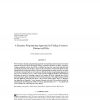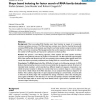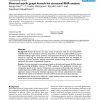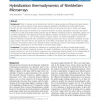96
Voted
BMCBI
2010
14 years 9 months ago
2010
Background: Recent studies have revealed the importance of considering the entire distribution of possible secondary structures in RNA secondary structure predictions; therefore, ...
106
click to vote
JCB
2007
15 years 7 days ago
2007
We developed a dynamic programming approach of computing common sequence structure patterns among two RNAs given their primary sequences and their secondary structures. Common pat...
116
click to vote
BMCBI
2006
15 years 12 days ago
2006
Background: One-dimensional protein structures such as secondary structures or contact numbers are useful for three-dimensional structure prediction and helpful for intuitive unde...
137
click to vote
BMCBI
2007
15 years 14 days ago
2007
Background: MicroRNAs (miRNAs) are recognized as one of the most important families of noncoding RNAs that serve as important sequence-specific post-transcriptional regulators of ...
100
Voted
BMCBI
2008
15 years 14 days ago
2008
Background: Most non-coding RNA families exert their function by means of a conserved, common secondary structure. The Rfam data base contains more than five hundred structurally ...
BMCBI
2008
15 years 14 days ago
2008
Background: The ability to access, search and analyse secondary structures of a large set of known RNA molecules is very important for deriving improved RNA energy models, for eva...
109
click to vote
BMCBI
2008
15 years 14 days ago
2008
Background: Recent discoveries of a large variety of important roles for non-coding RNAs (ncRNAs) have been reported by numerous researchers. In order to analyze ncRNAs by kernel ...
111
click to vote
BMCBI
2007
15 years 14 days ago
2007
Background: In recent years, RNA molecules that are not translated into proteins (ncRNAs) have drawn a great deal of attention, as they were shown to be involved in many cellular ...
BMCBI
2010
15 years 14 days ago
2010
Background: While microarrays are the predominant method for gene expression profiling, probe signal variation is still an area of active research. Probe signal is sequence depend...
111
Voted
3DPVT
2002
IEEE
15 years 5 months ago
2002
IEEE
In this paper we present a method for protein structure comparison that is based on indexing. Unlike most methods using indexing, ours does not use invariants of the C atoms of th...





